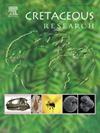再生潮汐:巴西Araripe盆地Aptian-Albian Romualdo组淡水双壳类动物Lazarus效应的地层学视角
IF 1.7
3区 地球科学
Q1 GEOLOGY
引用次数: 0
摘要
Aptian-Albian Romualdo组沉积在一个封闭的水生环境中,标志着至少三次不同的海洋入侵事件。该单元的大部分古生物知识来自于中部以页岩为主的层段,而地层上部以砂岩为主的相的化石资料仍然很少。这种数据的缺乏是因为上覆的沉积物要么被侵蚀,要么目前被新生代重力流沉积物掩盖。尽管如此,最上层的罗穆阿尔多组保留了潮汐主导的三角洲演替,记录了盆地逐渐回归大陆条件。在Sobradinho剖面中,在上部壳层段上方约10 m的层内支撑砾岩中发现了一种新的软体动物为主的组合。该组合包括骨碎片,植物遗骸和海洋/咸水软体动物。此外,淡水双壳类,以前只知道从克拉托组,也记录。所有大型无脊椎动物都表现出一致的保存模式,填充物由岩石基质组成。因此,淡水双壳类不是砾岩中较老沉积物的再加工化石。它们的存在表明,在罗穆阿尔多组沉积史的大部分时间里,这些淡水双壳类动物在河流和/或低盐度过渡或沿海环境中繁盛。如果没有这一新的记录,它们已知的垂直分布将主要局限于克拉托组基底三分之一富含双壳类的泥岩,以及在新报道的组合下方约100米的封闭海湾序列内的粉砂岩层。这一发现极大地扩展了它们作为相控拉撒路类群的地层范围。本文章由计算机程序翻译,如有差异,请以英文原文为准。
Tides of rebirth: A stratigraphic perspective on the Lazarus effect in freshwater bivalves in the Aptian-Albian Romualdo Formation, Araripe Basin, Brazil
The Aptian-Albian Romualdo Formation was deposited in a confined aquatic setting marked by at least three distinct marine ingression events. Most paleontological knowledge of this unit derives from the shale-dominated interval in its middle part, while fossil data from the sandstone-dominated facies in the uppermost part of the formation remain scarce. This paucity of data arises because the overlying deposits were either eroded or are currently obscured by Cenozoic gravity-flow deposits. Nonetheless, the uppermost Romualdo Formation preserves a tide-dominated delta succession, documenting the basin gradual return to continental conditions. In the Sobradinho section, a new mollusk-dominated assemblage is identified in an intraclast-supported conglomerate located ∼10 m above the upper shell bed interval. The assemblage includes bone fragments, plant remains, and marine/brackish-water mollusks. Additionally, freshwater bivalves, previously known only from the underlying Crato Formation, are also recorded. All macroinvertebrates exhibit a consistent preservational pattern, with infill composed of the rock matrix. Therefore, the freshwater bivalves are not reworked fossils from older sediments within the conglomerate. Their presence suggests that, for much of the Romualdo Formation depositional history, these freshwater bivalves thrived in riverine and/or low-salinity transitional or coastal environments. Without this new record, their known vertical distribution would remain largely confined to the bivalve-rich mudstones of the basal third of the Crato Formation and to a siltstone bed within a confined bay succession ∼100 m below the newly reported assemblage. This discovery significantly expands their stratigraphic range as facies-controlled Lazarus taxa.
求助全文
通过发布文献求助,成功后即可免费获取论文全文。
去求助
来源期刊

Cretaceous Research
地学-地质学
CiteScore
4.10
自引率
19.00%
发文量
235
审稿时长
12 weeks
期刊介绍:
Cretaceous Research provides a forum for the rapid publication of research on all aspects of the Cretaceous Period, including its boundaries with the Jurassic and Palaeogene. Authoritative papers reporting detailed investigations of Cretaceous stratigraphy and palaeontology, studies of regional geology, and reviews of recently published books are complemented by short communications of significant new findings.
Papers submitted to Cretaceous Research should place the research in a broad context, with emphasis placed towards our better understanding of the Cretaceous, that are therefore of interest to the diverse, international readership of the journal. Full length papers that focus solely on a local theme or area will not be accepted for publication; authors of short communications are encouraged to discuss how their findings are of relevance to the Cretaceous on a broad scale.
Research Areas include:
• Regional geology
• Stratigraphy and palaeontology
• Palaeobiology
• Palaeobiogeography
• Palaeoceanography
• Palaeoclimatology
• Evolutionary Palaeoecology
• Geochronology
• Global events.
 求助内容:
求助内容: 应助结果提醒方式:
应助结果提醒方式:


